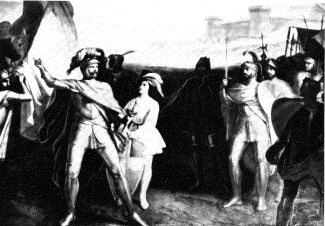When, in 1305, John II of Monferrato, successor of William VII, dies, Ivrea people destroy again the Castellazzo which from that time on will never be rebuilt and, according to the law, no building will have to be raised in that place (the rite of the "Podestà" oath repeats itself at Carnival with the ceremony of “the stone in the river Dora”). In the following years the Monferrato ‘s Marquises devoted themselves to solve problems of succession internal to their family and other two feudal families, neighbouring with the"Canavese", will take advantage of their weakness: the Savoia and the Acaia which were related between themselves.

It is necessary at this moment to specify that in 1308 Enrico VII of Luxembourg is elected emperor and he
would like to re-establish the North Italy submission to the empire.
The act of dedication of the people of Ivrea ‘s Commune to Amedeo VI of Savoy
In 1310, then, he descends to Italy for be crowned king. He found fidelity in the Acaia and he appointed therefore as a count of Savoy vicar of Ivrea’s city .
Enrico VII will be designated king by the Pope, but
the title is purely honorary (the North of Italy wasn’t submit itself to the emperor)
and in fact it will die out with his death in 1313.
Therefore, in those years Ivrea was obliged to swear fidelity to the emperor through the Savoy who in 1313, with the help of noble Ivrea families, obtained the submission of the town. The devotion act was signed definitly the 15 November 1313. But both the Savoy and the Acaia contended the right on the town and so it was decided that these would appoint alternatively he who would have to govern the town.
The principal
points of the agreement concerned: 1) the taxes of the salt, of the tolls, of the grain,
of the grindstones and of the horses are due to the Lords (Savoiy - Acaia) ; 2) the "Credenza" (that is the Town Council) can
make the Statutes, provided that no one was contrary to the
Savoia; 3) the Vicar or the "Podestà",
designed by Savoy, by appointment of the commune, must follow the Statutes; 4) the Lords
had to defend the town; 5) the Lords can build castles where they want.
The new owners of Ivrea and of the Canavese were occupied for years in wars and skirmishes both with the local Squires (counts of Masino, Valperga...), often at war between themselves, and with the Marquis of Monferrato who were implacable enemies of the Acaia.
In the meantime while Piedmont still had an feudal-type organization, even if with the presence of Communes, in the other parts of the North of Italy the Communes, who were real state-cities, transformed themselves into Seigniories where a Lord organizes his territory as a real state.
In 1347 the Seigneur of Milan, Luchino Visconti, helped the Marquis of Monferrato to take possession of Ivrea. Disputes were generated where also the Church interfered. Therefore two years later, in 1349, Ivrea was divided in two equal parts between the Marquis of Monferrato and the Count of Savoia (half of Chieri was assigned to the Acaia). But in 1356 "Giacomo d’Acaia" succeeded in taking possession of Ivrea. A disagreement rose between Amedeo VI of Savoia and "Giacomo d’Acaia" who, once defeated, accepted to be excluded from the Canavese. The same destiny concerned the Marquis of Monferrato. Amedeo VI, called the Green Count, remained therefore the only Lord of the town and, as a confirmation of his power, he began the construction of the castle. The castle is built above all for defensive aims and not so much as an abode. The Savoy, in fact, reside officially in Chambery in France (and then in Turin).
In 1365 Amedeo VI is designed imperial vicar of emperor Carlo IV (but he would not take much interest in Italian problems). With the Vicar’s position on the feudal lands, the clergymen, the nobles, the communes had to swear fidelity to the Count Amedeo of Savoia and ,moreover, he had the right to intervene in the emperor 's name in all cases when the peace was at risk. Amedeo VI acquired also the title of the previous feudal lords and then he became Marquis of Ivrea (this titlewas kept by all the Savoiy, also by the last king).
The extension of
the Savoy’s territories and their increased power was obviously not liked by feudal
lords of Canavese and especially by their long-standing enemies: the Marquis of
Monferrato, the Visconti and the Acaia. It is to be said, besides, that
Ivrea is situated in a strategic geographic position as it is an important trade center.
The Savoiy’s enemies, then, supported a popular revolt known with the name of “Tuchinaggio” which
broke out in 1386 in the Canavese. To intervene against this rebellion Amedeo VII, called the Red Count, was able, then with an
alternation of victories and defeats, to submit the "tuchini" in 1491.